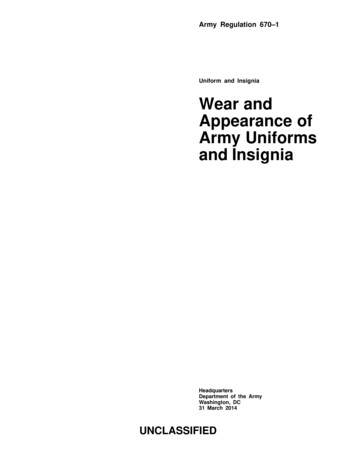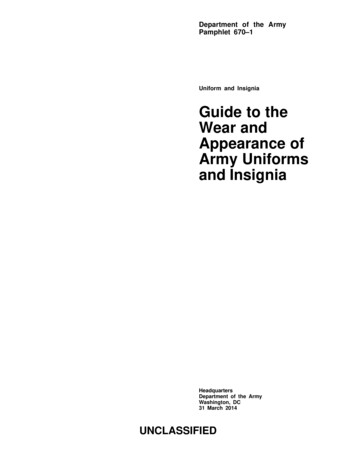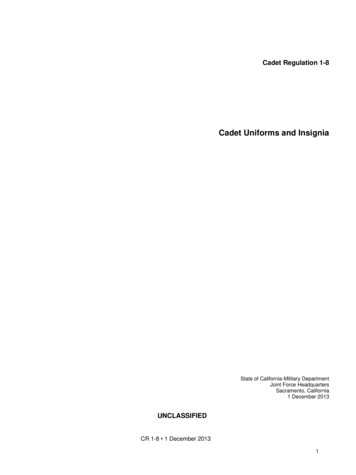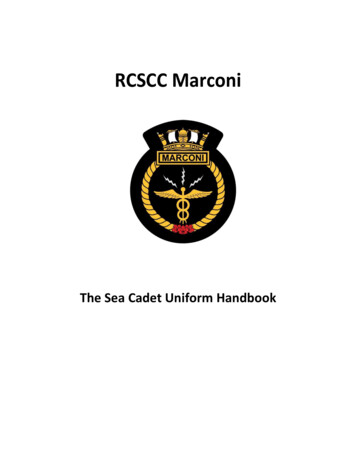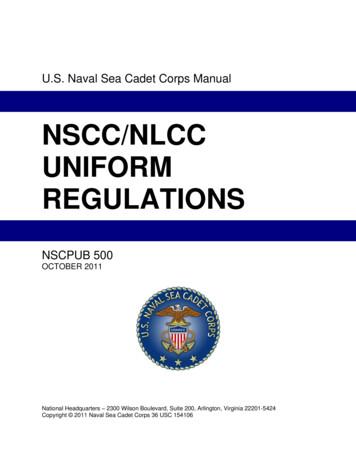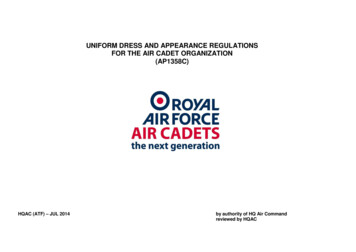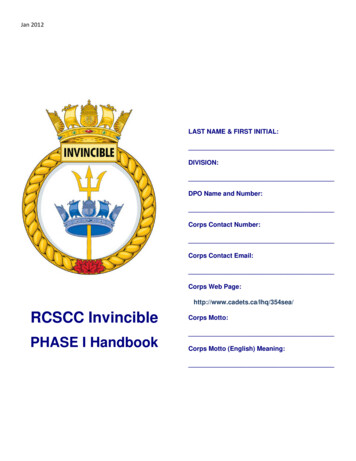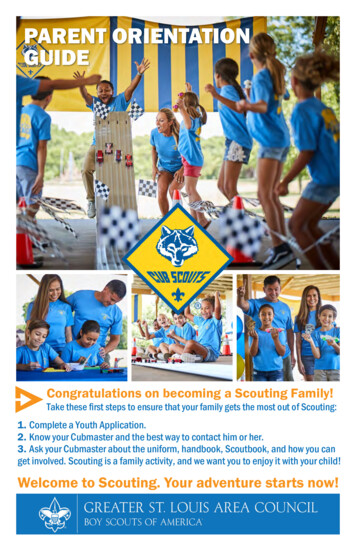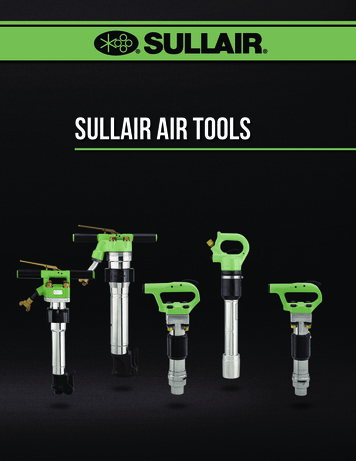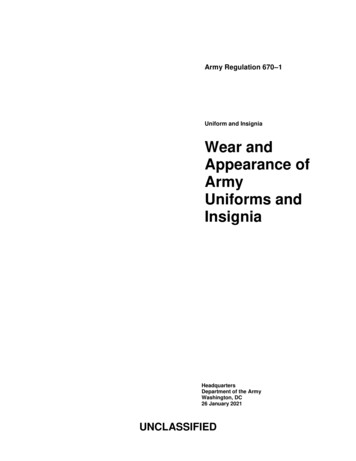
Transcription
Army Regulation 670–1Uniform and InsigniaWear andAppearance ofArmyUniforms andInsigniaHeadquartersDepartment of the ArmyWashington, DC26 January 2021UNCLASSIFIED
SUMMARY of CHANGEAR 670– 1Wear and Appearance of Army Uniforms and InsigniaThis major revision, dated 26 January 2021—oClarifies policy for breastfeeding or pumping in uniform and authorizes female Soldiers who are breastfeeding orpumping to wear an optional undershirt (para 3–6c).oUpdates guidance on the carrying of bags and backpacks (para 3–7f).oProvides correction for the rolling of sleeves in the Army Combat Uniform Coat (para 4–3b).oAdds Improved Hot Weather Combat Uniform as an authorized uniform (para 4 – 4).oImplements policy for the new Army green service uniform (chaps 14 and 15).oAdds guidance for wear and design of the shoulder sleeve insignia and wear of the distinctive unit insignia (paras21– 17).oAdds guidance on wear of shoulder sleeve insignia – military operations in hostile conditions (para 21 –18).oChanges Shoulder Sleeve Insignia – Former Wartime Service to Shoulder Sleeve Insignia – Military Operationsin Hostile Conditions (para 21– 18).oAdds dates to Somalia for wear of Shoulder Sleeve Insignia – Military Operations in Hostile Conditions (para21–18c(12)).oAdds guidance to allow wear of the Kosovo Forces (KFOR) brassard by Soldiers assigned to U.S. Army Europein support of operations with KFOR (para 21–30a).oAdds the Airborne and Ranger Training Brigade and the Airborne and Special Operations Test Directorate, U.S.Army Operational Test Command, to the list of units approved by The Institute of Heraldry to wear the airbornetab with any other shoulder sleeve insignia (para 22 – 12).oAdds authorization for retiree shoulder sleeve insignia (para 23–3h).oRemoves references to Universal Camouflage Pattern (throughout).
*Army Regulation 670 –1HeadquartersDepartment of the ArmyWashington, DC26 January 2021Effective 26 February 2021Uniform and InsigniaWear and Appearance of Army Uniforms and InsigniaCorps of Cadets, U.S. Military Academy,only when their respective uniform regulations do not include sufficient guidanceor instruction. It does not apply to theChief of Staff of the Army, or formerChiefs of Staff of the Army, each ofwhom may prescribe their own uniform.Portions of this regulation are punitive.Violation of the specific prohibitions andrequirements of specific portions by Soldiers may result in adverse administrativeaction and/or charges under the UniformCode of Military Justice.of the requesting activity and forwardedthrough their higher headquarters to thepolicy proponent. Refer to AR 25 – 30 forspecific guidance.Army internal control process.This regulation contains internal controlprovisions in accordance with AR 11 –2and identifies key internal controls thatmust be evaluated (see appendix B).Supplementation. Supplementationof this regulation and the establishment ofcommand and local forms are prohibitedwithout prior approval from the DeputyProponent and exception authority.Chief of Staff, G– 1 (DAPE – ZA/UniformThe proponent of this regulation is theHistory. This publication is a major re- Deputy Chief of Staff, G– 1. The propo- Policy), 300 Army Pentagon, Washington, DC 22310– 0300.vision.nent has the authority to approve excepSummary. This regulation prescribes tions or waivers to this regulation that are Suggested improvements. UsersDepartment of the Army policy for proper consistent with controlling law and regu- are invited to send comments and sugwear and appearance of Army uniforms lations. The proponent may delegate this gested improvements on DA Form 2028and insignia, as worn by officers and en- approval authority, in writing, to a divi- (Recommended Changes to Publicationslisted personnel of the Regular Army, the sion chief within the proponent agency or and Blank Forms) directly to the DeputyU.S. Army Reserve, and former Soldiers. its direct reporting unit or field operating Chief of Staff, G– 1 (DAPE – ZA/Uniformagency in the grade of colonel or the civil- Policy), 300 Army Pentagon, WashingApplicability. This regulation applies ian equivalent. Activities may request a ton, DC 22310– 0300.to the Regular Army, the Army National waiver to this regulation by providing jusGuard/Army National Guard of the tification that includes a full analysis of Distribution. This regulation is availaUnited States, and the U.S. Army Re- the expected benefits and must include ble in electronic media only and is inserve, unless otherwise stated. It also ap- formal review by the activity’s senior le- tended for Regular Army, the Army Naplies to Army Civilians and Veterans, the gal officer. All waiver requests will be en- tional Guard/Army National Guard of theReserve Officers’ Training Corps, and the dorsed by the commander or senior leader United States, and the U.S. Army Reserve.Contents (Listed by paragraph and page number)Chapter 1Introduction, page 1Purpose 1 – 1, page 1References and forms 1 – 2, page 1Explanation of abbreviations and terms 1 – 3, page 1Responsibilities 1 – 4, page 1Records management (recordkeeping) requirements 1 – 5, page 1Authority 1 – 6, page 1Recommending changes to Army uniforms 1 – 7, page 1Classification of service and combat/utility/field uniforms 1 – 8, page 2Chapter 2Responsibilities, page 2*This regulation supersedes AR 670-1, dated 25 May 2017.AR 670–1 26 January 2021UNCLASSIFIEDi
Contents—ContinuedThe Assistant Secretary of the Army (Acquisition, Logistics and Technology) and Commanding General, U.S. ArmyMateriel Command 2 – 1, page 2Administrative Assistant to the Secretary of the Army 2 – 2, page 2Deputy Chief of Staff, G – 1 2 – 3, page 3Deputy Chief of Staff, G – 4 2 – 4, page 3Commanders of Army commands, Army service component commands, and direct reporting units 2 – 5, page 3Chief of Army Reserve 2 – 6, page 3Chief, National Guard Bureau 2 – 7, page 3Army commanders at all levels 2 – 8, page 4Director and Chief Executive Officer, U.S. Army and Air Force Exchange Service 2 – 9, page 5Soldiers 2 – 10, page 5Chapter 3Appearance and Grooming Policies, page 5Personal appearance policies 3 – 1, page 5Hair and fingernail standards and grooming policies 3 – 2, page 6Tattoo, branding, and body mutilation policy 3 – 3, page 12Jewelry 3 – 4, page 14Wear of Army uniform at national, regional, and local events 3 – 5, page 15Uniform appearance and fit 3 – 6, page 15Required or prohibited wearing of the Army uniform 3 – 7, page 16Distinctive uniforms and uniform items 3 – 8, page 18Civilian clothing 3 – 9, page 18Eyeglasses, sunglasses, and contact lenses 3 – 10, page 18Identification tags and security identification badges 3 – 11, page 19Personal protective or reflective clothing 3 – 12, page 19Organizational protective or reflective clothing 3 – 13, page 19Heraldic items 3 – 14, page 19Religious jewelry, apparel, or articles 3 – 15, page 20Religious accommodations 3 – 16, page 21Chapter 4Combat Uniform, page 24Authorization for wear 4 – 1, page 24Composition 4 – 2, page 24Occasions for wear 4 – 3, page 25Improved Hot Weather Combat Uniform 4 – 4, page 25Chapter 5Maternity Work Uniform, page 25Authorization for wear 5 – 1, page 25Composition 5 – 2, page 26Occasions for wear 5 – 3, page 26Chapter 6Aircrew Uniform, page 26Authorization for wear 6 – 1, page 26Composition 6 – 2, page 26Occasions for wear 6 – 3, page 26Chapter 7Garrison Culinary Uniform-Male, page 27Authorization for wear 7 – 1, page 27Composition 7 – 2, page 27Occasions for wear 7 – 3, page 27AR 670–1 26 January 2021ii
Contents—ContinuedChapter 8Garrison Culinary Uniform-Female, page 27Authorization for wear 8 – 1, page 27Composition 8 – 2, page 27Occasions for wear 8 – 3, page 28Chapter 9Combat Vehicle Crewman Uniform, page 28Authorization for wear 9 – 1, page 28Composition 9 – 2, page 28Occasions for wear 9 – 3, page 28Chapter 10Physical Fitness Uniform, page 29Authorization for wear 10 – 1, page 29Composition 10 – 2, page 29Occasions for wear 10 – 3, page 29Chapter 11Army Service Uniform-Male, page 29Authorization for wear 11 – 1, page 29Composition 11 – 2, page 29Occasions for wear 11 – 3, page 30Chapter 12Army Service Uniform-Female, page 30Authorization for wear 12 – 1, page 30Composition 12 – 2, page 30Occasions for wear 12 – 3, page 31Chapter 13Army Service Uniform-Maternity, page 31Authorization for wear 13 – 1, page 31Composition 13 – 2, page 31Occasions for wear 13 – 3, page 31Chapter 14Army Green Service Uniform, page 32Authorization for wear 14 – 1, page 32Composition 14 – 2, page 32Occasions for wear 14 – 3, page 32Chapter 15The Army Green Service Uniform-Maternity, page 33Authorization for wear 15 – 1, page 33Composition 15 – 2, page 33Classification 15 – 3, page 33Occasions for wear 15 – 4, page 33Chapter 16Blue Mess Uniforms-Male, page 34Authorization for wear 16 – 1, page 34Composition 16 – 2, page 34Occasions for wear 16 – 3, page 34Chapter 17Blue Mess Uniforms-Female, page 34AR 670–1 26 January 2021iii
Contents—ContinuedAuthorization for wear 17 – 1, page 34Composition 17 – 2, page 34Occasions for wear 17 – 3, page 35Chapter 18White Mess Uniforms-Male, page 35Authorization for wear 18 – 1, page 35Composition 18 – 2, page 35Occasions for wear 18 – 3, page 35Chapter 19White Mess Uniforms-Female, page 36Authorization for wear 19 – 1, page 36Composition 19 – 2, page 36Occasions for wear 19 – 3, page 36Chapter 20Uniform Accessories, page 37General 20 – 1, page 37Bags, handbags, purses, and backpacks 20 – 2, page 37Belts and buckles 20 – 3, page 37Beret 20 – 4, page 37Boots 20 – 5, page 37Buttons 20 – 6, page 37Capes (officers only) 20 – 7, page 37Chaplain’s apparel 20 – 8, page 37Coat, all-weather (male and female) 20 – 9, page 37Cover, cap, rain 20 – 10, page 37Cuff links and studs 20 – 11, page 37Cummerbunds (male and female) 20 – 12, page 37Fleece cap 20 – 13, page 37Garrison cap 20 – 14, page 37Gloves 20 – 15, page 37Hat, drill sergeant 20 – 16, page 38Jackets and windbreakers 20 – 17, page 38Judge’s apparel 20 – 18, page 38Military police accessories 20 – 19, page 38Neckgaiter 20 – 20, page 38Neck tabs, female 20 – 21, page 38Neckties 20 – 22, page 38Overcoat, ceremonial, blue 20 – 23, page 38Overshoes, black 20 – 24, page 38Scarves 20 – 25, page 38Shirts, white 20 – 26, page 38Shoes 20 – 27, page 38Socks 20 – 28, page 38Suspenders 20 – 29, page 38Sweaters 20 – 30, page 38Umbrella 20 – 31, page 38Undergarments 20 – 32, page 38Vest, male 20 – 33, page 38Chapter 21Wear of Insignia and Accoutrements, page 39General 21 – 1, page 39General description 21 – 2, page 39AR 670–1 26 January 2021iv
Contents—ContinuedHeadgear insignia 21 – 3, page 39U.S. Insignia 21 – 4, page 39Grade insignia for general officers 21 – 5, page 39Grade insignia for other officers 21 – 6, page 39Grade insignia for enlisted personnel 21 – 7, page 39Other grade insignia 21 – 8, page 39Branch insignia 21 – 9, page 39Branch insignia-other 21 – 10, page 40Insignia for aides 21 – 11, page 41Branch insignia-how worn, Army service uniform 21 – 12, page 41Branch insignia-how worn, Army green service uniform 21 – 13, page 41Insignia for United States Military Academy staff 21 – 14, page 41Branch insignia-officer candidates 21 – 15, page 41Insignia for warrant officer candidates 21 – 16, page 41Shoulder sleeve insignia—current organization 21 – 17, page 41Shoulder sleeve insignia–military operations in hostile conditions 21 – 18, page 42Wear of U.S. flag embroidered insignia 21 – 19, page 45Branch colors 21 – 20, page 45Branch scarves 21 – 21, page 45Distinctive unit insignia 21 – 22, page 45Regimental distinctive insignia 21 – 23, page 46Insignia representing regimental affiliation 21 – 24, page 47Insignia, distinguishing, U.S. Army nametape and nameplate 21 – 25, page 47Aiguillette, service 21 – 26, page 47Aiguillette, dress 21 – 27, page 47Service stripes 21 – 28, page 47Overseas service bars 21 – 29, page 47Brassards 21 – 30, page 48Distinctive items authorized for infantry personnel 21 – 31, page 48Distinctive items authorized for other than infantry personnel 21 – 32, page 49Chapter 22Wear of Decorations, Service Medals, Badges, Unit Awards, and Appurtenances, page 50General 22 – 1, page 50Authorization 22 – 2, page 50When wearing awards is prohibited 22 – 3, page 50Order of precedence by category of medal 22 – 4, page 50Order of precedence within categories of medals 22 – 5, page 50Wear of service ribbons and lapel buttons 22 – 6, page 50Full-sized U.S. and foreign decorations and service medals 22 – 7, page 51Miniature decorations and service medals 22 – 8, page 51Multiple neck ribbons, broad sashes, and stars 22 – 9, page 51U.S. and foreign unit awards 22 – 10, page 51Appurtenances 22 – 11, page 52Badges authorized for wear on Army uniforms 22 – 12, page 53Badges not authorized for wear on Army uniforms 22 – 13, page 54Categories of badges authorized for wear on Army uniforms 22 – 14, page 54Marksmanship badges and tabs 22 – 15, page 54Combat and special skill badges 22 – 16, page 54Identification badges 22 – 17, page 54Foreign badges 22 – 18, page 55Chapter 23Wear of the Army Uniform by Reserve, Retired, Separated, and Civilian Personnel, page 55Occasions of ceremony 23 – 1, page 55U.S. Army Reserve 23 – 2, page 55AR 670–1 26 January 2021v
Contents—ContinuedRetired personnel 23 – 3, page 56Former members of the Army 23 – 4, page 56Medal of Honor recipients 23 – 5, page 56Medals on civilian clothes 23 – 6, page 57Prohibition on uniform wear 23 – 7, page 57Uniform similar to the Army uniform 23 – 8, page 57Distinctive unit insignia on civilian clothing 23 – 9, page 57Uniforms worn by United States civilians 23 – 10, page 57AppendixesA. References, page 58B. Internal Control Evaluation, page 61Figure ListFigure 3 – 1: Male grooming standards, page 9Figure 3 – 2: Prohibited male haircuts, page 10Figure 3 – 3: Female hairstyle standards, page 11Figure 3 – 4: Measurement figure, page 12Figure 3 – 5: Hijab, page 22Figure 3 – 6: Beard figure, page 23Figure 3 – 7: Turban figure, page 24GlossaryAR 670–1 26 January 2021vi
Chapter 1Introduction1–1. PurposeThe Army is a profession. A Soldier’s appearance measures part of their professionalism. Proper wear of the Armyuniform is a matter of personal pride for all Soldiers. It is indicative of esprit de corps and morale within a unit.Soldiers have an individual responsibility for ensuring their appearance reflects the highest level of professionalism.Leaders, at all levels, have a responsibility for implementing and applying the standards contained in this regulationto ensure the best interests of the Army, including our shared traditions and customs. This regulation prescribes theauthorization for wear, composition, and classification of uniforms, and the occasions for wearing all personal (clothing bag issue), optional, and commonly worn organizational clothing, and individual equipment uniforms. It prescribesthe uniforms, awards, insignia, and accoutrements authorized for wear. It also provides general information on theauthorized material and design of uniforms and the uniform quality control system.1–2. References and formsSee appendix A.1–3. Explanation of abbreviations and termsSee the glossary.1–4. ResponsibilitiesResponsibilities are listed in chapter 2.1–5. Records management (recordkeeping) requirementsThe records management requirement for all record numbers, associated forms, and reports required by this regulationare addressed in the Army Records Retention Schedule-Army (RRS– A). Detailed information for all related recordnumbers, forms, and reports are located in Army Records Information Management System (ARIMS)/RRS – A athttps://www.arims.army.mil. If any record numbers, forms, and reports are not current, addressed, and/or publishedcorrectly in ARIMS/RRS – A, see DA Pam 25 – 403 for guidance.1–6. Authoritya. Portions of this regulation are punitive. Violation of the specific prohibitions and requirements of specific portions by Soldiers may result in adverse administrative action and/or charges under the provisions of the Uniform Codeof Military Justice (UCMJ).b. Only uniforms, accessories, and insignia prescribed in this regulation, found in the common table of allowances(CTA), or as approved by Headquarters, Department of the Army (HQDA), will be worn by personnel in the U.S.Army. Unless specified in this regulation, the commander issuing the clothing and individual equipment will establishwear policies for organizational clothing and individual equipment. No item governed by this regulation will be alteredin any way that changes the basic design, or the intended concept of fit, as described in AR 700 – 84, including plating,smoothing, or removing detailed features of metal items, or otherwise altering the color or appearance.c. AR 70 – 1 prescribes Department of the Army (DA) policies, responsibilities, and administrative procedures bywhich all clothing and individual equipment used by Army personnel are initiated, designed, developed, tested, approved for acquisition, fielded, and modified.d. AR 385 – 10 prescribes DA policies, responsibilities, and administrative procedures and funding for protectiveclothing and equipment.e. In accordance with Title 10, United States Code, Section 771 (10 USC 771), no person except a member of theU.S. Army may wear the uniform, a distinctive part of the uniform, or a uniform any part of which is similar to adistinctive part of the U.S. Army uniform, unless otherwise authorized by law. Soldiers are not authorized to weardistinctive uniforms or uniform items of the U.S. Army or of other U.S. Services with, or on, civilian clothes, exceptas authorized by this regulation.1–7. Recommending changes to Army uniformsSee DA Pam 670 – 1.AR 670–1 26 January 20211
1–8. Classification of service and combat/utility/field uniformsSee DA Pam 670 – 1.Chapter 2Responsibilities2–1. The Assistant Secretary of the Army (Acquisition, Logistics and Technology) andCommanding General, U.S. Army Materiel CommandThe CG, AMC is responsible for the Uniform Quality Control Program (UQCP). ASA (ALT) and CG, AMC willensure that program executive office (PEO) Soldier and Project Manager, Soldier Survivability, in conjunction withthe Combat Capabilities Development Command (CCDC) Soldier Center, will—a. Prepare and maintain military specifications, purchase descriptions, and master patterns for optional uniformitems, as recommended by the Army Uniform Board and approved by the Chief of Staff, Army (CSA) in accordancewith AR 70 – 1.b. Publish and disseminate periodic bulletins to industry that provide guidance and information regarding changesin military specifications, testing and certification requirements, uniform regulations, or adoption of new optionaluniform items.c. Furnish specifications, purchase descriptions, master patterns, shade standards, and other information about optional uniforms to industry, when required.d. Receive and examine laboratory test reports, manufacturer certifications, and samples from commercial manufacturers, custom tailors, military tailors, and other suppliers of optional uniform items, as required. Require manufacturers to provide requested laboratory test reports, manufacturer certifications, and samples of optional uniformitems at no cost to the Army.e. Issue certificates of authority to manufacturers whose samples meet or exceed standards established by specifications of purchase descriptions. Certificates will be supplemented by documents showing the specific optional uniform items that the manufacturer is authorized to produce. Provide a list of certified manufacturers and products thatwill be furnished to the Army and Air Force Exchange Service (AAFES) and posted on appropriate Army websites.Revoke or suspend certificates when the certificate holder has violated any of the expressed conditions under whichthe certification was granted, as determined by PEO Soldier.f. Conduct inspections and otherwise monitor manufacturers for compliance with certificate terms and conditions.Review optional uniform items to verify compliance with, or appropriate exemption/waiver from, applicable domesticsource requirements as set forth in 10 USC 2533a. Coordinate with designated service points of contact to ensure thatoutside the United States produced optional uniform items are evaluated and approved prior to being sold withintheater to Soldiers. Outside the United States Army service component commands (ASCCs) will establish servicepoints of contact to direct local textile and uniform producers desiring to sell optional uniform items to Soldiers to theCCDC Soldier Center for coordination.g. Ensure manufacturers and suppliers of optional uniform items do the following:(1) Obtain certification required under the UQCP from the CCDC Soldier Center or Project Manager, SoldierSurvivability before manufacturing any optional uniform items for sale.(2) Affix a label with the following information certifying the optional uniform items were manufactured in accordance with the UQCP prior to offering the items for sale: This item is warranted to meet or exceed the standardsof specification number and was produced under certificate number from basic material warranted by the manufactureras having been produced in accordance with the sample under current certification. This item is not authorized forturn-in to central issue facilities.(3) Familiarize themselves with Army specifications, purchase descriptions, testing/certification requirements,shade standards, and other pertinent information for optional uniform items, and submit required samples and information to the CCDC Soldier Center or Project Manager, Soldier Survivability for approval.(4) Comply with all terms of the certification. Certificates may be revoked or suspended if the certificate holderhas violated any of the expressed conditions of the certification.2–2. Administrative Assistant to the Secretary of the ArmyThe AASA ensures that The Institute of Heraldry (TIOH) will—a. Monitor the Heraldic Quality Control Program in accordance with AR 672 – 8, to ensure heraldic items are manufactured according to Government specifications or purchase descriptions.b. Provide manufacturers with Government-loaned tools and specifications for heraldic items.AR 670–1 26 January 20212
c. Authorize the manufacture of heraldic items and issue certificates of authority to manufacture items in accordance with the provisions of AR 672 – 8.d. Approve designs for distinctive unit insignia (DUI), regimental distinctive insignia (RDI), shoulder sleeve insignia (SSI), flags, and badges, as authorized by this regulation.e. Prepare and maintain specifications, manufacturing drawings and purchase descriptions for insignia worn on theArmy uniforms.2–3. Deputy Chief of Staff, G –1The DCS, G– 1 will—a. Under the authority of the Assistant Secretary of the Army (Manpower and Reserve Affairs) (ASA (M&RA)),develop policies regarding wear and appearance of Army uniforms and insignia.b. Function as a member of the Army Uniform Board, which is established in accordance with AR 70 – 1.c. Coordinate with AAFES and the DCS, G – 4, as required, to incorporate uniform changes or additions to thisregulation and/or DA Pam 670 – 1.2–4. Deputy Chief of Staff, G –4The DCS, G– 4 will—a. Be responsible for the life cycle management of clothing and individual equipment, in accordance with AR70 – 1.b. Coordinate the Army Uniform Board meetings in accordance with AR 70 – 1.2–5. Commanders of Army commands, Army service component commands, and direct reportingunitsThe Commanders of ACOMs, ASCCs, and DRUs will thoroughly evaluate all submitted proposals (with a significantproposed change) to change or add uniforms, accessories, or wear policies for uniforms, insignia, and awards.2–6. Chief of Army ReserveThe CAR and Commanding General, U.S. Army Reserve Command (USARC) may publish, in writing, restrictionson the wearing of utility and organizational uniforms off military installations.2–7. Chief, National Guard BureauThe CNGB will—a. Ensure State adjutants general publish in writing restrictions they implement on the wearing of utility and organizational uniforms off military installations.b. Ensure that commanders of ARNG divisions, separate brigades, infantry regiments, the infantry scout group,and State adjutants general for separate infantry battalions and companies authorize wear of the shoulder cord forARNG Soldiers who have successfully completed the appropriate training.c. Ensure that ARNG military technicians who are required to wear the uniform as a condition of their employmentwill wear the uniform for their federally recognized grade, as prescribed by the Adjutant General of their State, commonwealth, territory, or district.d. Ensure that ARNG personnel who wear the Army uniform in the performance of State service are authorized todo so by the Adjutant General for their State, commonwealth, territory, or district.e. Ensure that ARNG technicians, who are also members of the ARNG, wear the appropriate Army duty uniformwhile engaged in their civil service status.f. Ensure that recruiting and retention managers (O – 5 or above) make initial entry determinations for ARNG Soldiers that tattoos or brands comply with policy (see para. 3 – 3). This authority will not be delegated further.g. Ensure that ARNG Soldiers wear SSI as follows:(1) Members of the ARNG not in active Federal service wear the SSI of the division, separate brigade, or separatecavalry regiment to which assigned, including brigades integrated into RA divisions.(2) Members of a troop command, recruiting ARNG assigned to the ARNG Element Joint Forces Headquarters,and its detachments and retention, medical detachment, training sites, and support units not authorized an SSI wearthe ARNG Element Joint Forces Headquarters SSI designed for that state, commonwealth, territory, or district. However, members of the Selective Service System section will wear the Selective Service System SSI.AR 670–1 26 January 20213
(3) Assigned and attached staff and faculty members of ARNG activities that are part of the Total Army SchoolSystem (TASS) wear the ARNG TASS SSI. These activities include TASS regional training institute, brigades, regiments, battalions, squadrons, companies, batteries, and troops; NCO academies, special training sites; the ARNGprofessional education center; and the National Guard marksmanship training unit.(4) Members of ARNG units not authorized a distinctive SSI, other than those indicated in paragraphs 21–17d(9)(a)through 21–17d(9)(c), wear the insignia of their ARNG Element Joint Forces Headquarters.h. Ensure that ARNG trainees wear the insignia of their parent ARNG organization as soon as they are issueduniforms and that their parent units provide initial entry training Soldiers with their SSI before they enter initial entrytraining.i. Ensure that all members of the ARNG on any form of paid or unpaid inactive duty, active duty, annual training,full-time National Guard duty, or AGR duty will wear the uniform and insignia prescribed for personnel in the RA.ARNG personnel are authorized to wear the Army uniform on occasions specified in para. 23 – 2:j. Ensure that ARNG Soldiers do not wear the Army uniform under the prohibited circumstances listed in paragraph3–7k.k. When State Defense Forces (SDF) adopt the Army service uniform and the Army utility uniform, ensure that allservice uniform buttons, cap devices, and other insignia differ significantly from that prescribed for wear by membersof the U.S. Army. Ensure that State insignia does not include “United States,” “U.S.,” “U.S. Army,” or the Great Sealof the United States. Personnel of the SDF may wear a State-designed SDF distinguishing badge or insignia centeredon the left pocket flap. Ensure that the red nametape or nameplate includes the full title of the SDF (for example,“Texas State Guard”). Ensure the utility uniforms contains a State SDF tape in lieu of “U.S. Army” over the left breastpocket. And ensure that States wishing to adopt the Army service and utility uniforms register with the CNGB.l. Ensure that ARNG personnel comply with the applicable provisions of this regulation and the guidance publishedin DA Pam 670 – 1.2–8. Army commanders at all levelsa. Senior commanders may prescribe the uniform for wear in formations. When not prescribed by the senior commander, unit commanders will prescribe the uniform for wear in formation.b. The commander in charge of units on maneuver may prescribe the uniform for wear within the maneuver area.c. Commanders of ceremonial units or with ceremonial details are as follows:(1) Members of honor guards, color guards, and similar details will wear the prescribed Army service, dress, orutility uniforms with authorized accoutrements. These members may wear accessories authorized in CTA 50 – 900(such as individual equipment, belts, white gloves, and slings) when authorized by the commander. Commanders willprescribe uniform wear policies for these items.(2) Only those units authorized to wear a distinctive uniform in accordance with CTA 50 – 900 for ceremonialduties, such as the Old Guard and the U.S. Army Band, are exempt from the policy to wear the Army service, dress,or utility uniforms in the performance of ceremonial duties. Commanders of special units will prescribe the wearpolicy for all distinctive uniform items and accoutrements.d. Commanders will not require individuals to purchase optional uniform items. Likewise, they will not restrict ordiscourage them from wearing optional uniform ite
Coat, all-weather (male and female) 20 – 9, page 37 Cover, cap, rain 20 – 10, page 37 Cuff links and studs 20 – 11, page 37 Cummerbunds (male and female) 20 – 12, page 37 Fleece cap 20 – 13, page 37 Garrison cap 20 – 14, page 37 Gloves 20 – 15, p
